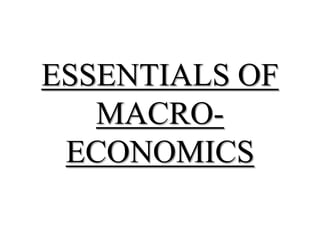
Fiscal-Policy-101 : easy-economics
- 1. ESSENTIALS OF MACRO- ECONOMICS
- 2. GROUP DETAILS COLLEGE : H L INSTITUE OF COMMERCE YEAR : FIRST YEAR COURSE : BACHELOR OF COMMERCE SECTION :2 GROUP NUMBER :5 TRIMESTER :3 ROLL NUMBER STUDENT NAME 170 Parth Jain 171 Pratik Jain 172 Pratik Jain 173 Priyanshi Jain 174 Purvi Jain 175 Romit Jain 176 Ruchika Jain 178 Sakshi Jain 180 Sarthak Jain 181 Shivangi Jain
- 4. DE-CONSTRUCTING THE FISC : A BRIEF REPORT ON FISCAL POLICY
- 5. FISCAL POLICY • Meaning : Fiscal Policy is a policy under which government uses its revenue and expenditure programs to produce desirable effects and avoid undesirable effects on macro economic variables. • Scope : Scope means the coverage/ambit of fiscal policy. It has two components : 1. Fiscal Instruments 2. Target Variables • Components : Fiscal Policy has 2 components, namely : 1. Revenue Budget 2. Expenditure Budget
- 6. FISCAL INSTRUMENTS • These are the tools/levers, the government can use to stimulate the target variables i.e. the macro economic indicators. • Also known as fiscal tools, fiscal levers and fiscal handles • Significant Fiscal Instruments include : 1. Budgetary Balance Policy 2. Government Expenditure 3. Taxation Policy 4. Borrowings
- 7. BUDGETARY BALANCE POLICY • The decision to chalk out a balanced or surplus or deficit budget is covered here. • The decision regarding the type of budget depends on various variables. Significant among them are – 1. Fiscal head-room available to government 2. Stage of development of the economy 3. Growth target of the government
- 8. GOVERNMENT EXPENDITURE • Government expenditure includes expenditure on purchase of – 1. goods and services 2. public investment 3. transfer payments • Government expenditure is an injection into the economy. It adds to the overall aggregate effective demand in the economy. • The impact of government expenditure depends upon how it is financed and its multiplier effect.
- 9. Government Expenditure Economic Growth Stability Employment Recession Boom Increase Expenditure Decrease Expenditure
- 10. TAXATION POLICY • Tax means a non quid pro quo transfer of private income to public treasury by means of taxes (direct and indirect). • Direct taxes includes taxes on personal incomes, corporate incomes, wealth and property. • Indirect taxes, also called commodity taxes, includes VAT, excise, CST and customs.
- 11. Taxation Employment Generation Stability Economic Growth Boom Recession Raise rates Decrease Rates Taxes on production and import Of capital intensive goods Subsidization of labour intensive goods
- 12. BORROWINGS • Borrowing includes internal and external borrowings. • Internal borrowings are of two types : 1. issuing government bonds and T-bills to public 2. deficit financing • External borrowings includes borrowings from: 1. foreign governments 2. international organizations 3. market borrowings
- 13. RELATIONSHIP BETWEEN BORROWINGS AND ECONOMIC GROWTH: CONTROVERSIES REGARDING CROWDING-OUT AND CROWDING-IN
- 14. CROWDING-OUT • Meaning : It is the fall in private investment due to deficit spending by the government • Mechanism : 1. Deficit spending through deficit financing Deficit Financing Increase in money supply, but static supply of commodities Inflationary Trend Tight money policy = Increasing interest rates “Choking off“ of private investment
- 15. • 2. Deficit spending through market borrowings : Market borrowings Sale of government bonds and T-bills Transfer of purchasing power to government Fall in private investible surplus Crowding Out of private investment • Effect : Because of crowding-out of private investment, the expansionary effect of the deficit spending on the economy reduces or sometimes even gets neutralized.
- 16. CROWDING-IN • Meaning : It means rise in the private investment due to deficit spending by the government • Mechanism : Deficit Spending Increase in interest rates and aggregate demand Increase in production to cater increased demand More utilization of existing capital stock Increase in demand for capital i.e. crowding-in of investment • Effect : Deficit spending spurs private investment
- 17. TARGET VARIABLES • The target variables are the macro variables that are intended to be stimulated to achieve the intended macro-economic results. in simple words, fiscal instruments are “means to an end” and target variables are the “end.” • Such target variables include – 1. Private disposable incomes 2. Private consumption 3. Private savings & investment 4. Exports and imports
- 18. FISCAL POLICY FOR ECONOMIC EQUALITY • Disparity is inherent in any system • But disparity beyond a level, is undesirable. So it is prudent to keep disparity within acceptable levels • Tax policy to eradicate economic inequality : 1. Tax at progressive rates 2. Tax on wealth and property 3. Exorbitant taxes on luxury goods • Government expenditure policy to eradicate economic inequality : 1. Reallocation of capex to rural areas 2. Spending on skill development 3. Providing incubators for start ups
- 19. LIMITATIONS 1. Unreliable data and no proper method of forecasting 2. In under-developed economies, following problems plague fiscal policy : i) low levels of income ii) small population under tax net iii) existence of parallel economy iv) pervasive corruption 3. Time consuming to formulate a comprehensive policy 4. Inflationary trend due to deficit financing
- 20. MORE ABOUT OUR ARTICLE • Talks about wisdom of fiscal tightening • Reflects upon usefulness of fiscal tightening for india • Also reflects upon need for cheap money policy in the west • Teaches a truth : “Get your facts first, then you can distort them as you please.” - MARK TWAIN
- 21. BIBLIOGRAPHY 1. www.economictimes.indiatimes.com 2. www.slideshare.net 3. www.youtube.com 4. www.fourhourworkweek.com/blog 5. en.wikipedia.org/wiki/Keynesian_economics 6. Course material provided by our college 7. www.brainyquote.com
- 22. RELATIONSHIP BETWEEN ECONOMICS AND ONE-LINERS “An economist is a man who knows a hundred ways of making love but doesn’t know any women.” - ART BUCHWALD “Government's view of the economy could be summed up in a few short phrases: If it moves, tax it. If it keeps moving, regulate it. And if it stops moving, subsidise it.” - RONALD REAGAN
- 23. GRACIAS